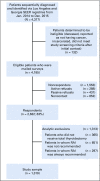Patient-Perceived Lack of Choice in Receipt of Radioactive Iodine for Treatment of Differentiated Thyroid Cancer
- PMID: 31283406
- PMCID: PMC6698919
- DOI: 10.1200/JCO.18.02228
Patient-Perceived Lack of Choice in Receipt of Radioactive Iodine for Treatment of Differentiated Thyroid Cancer
Abstract
Purpose: For many patients with differentiated thyroid cancer, use of radioactive iodine (RAI) does not improve survival or reduce recurrence risk. Yet there is wide variation in RAI use, emphasizing the importance of understanding patient perspectives regarding RAI decision making.
Patients and methods: All eligible patients diagnosed with thyroid cancer from 2014 to 2015 from the Georgia and Los Angeles SEER registries were surveyed (N = 2,632; response rate, 63%). Patients in whom selective RAI use is recommended were included in this analysis (n = 1,319). Patients were asked whether they felt like they had a choice to receive RAI (yes or no), how strongly their physician recommended RAI (5-point Likert-type scale), whether they received RAI (yes or no), and how satisfied they were with their RAI decision (more [score of 4 or greater] v less). Multivariable, weighted logistic regression with multiple imputation was used to assess the associations between patient characteristics and perception of no RAI choice and between perception of no RAI choice with receipt of RAI and decision satisfaction.
Results: More than half of respondents (55.8%) perceived they did not have an RAI choice, and the majority of patients (75.9%) received RAI. The odds of perceiving no RAI choice was greater among those whose physician strongly recommended RAI (adjusted odds ratio [OR], 1.56; 95% CI, 1.13 to 2.17). Patients who perceived they did not have an RAI choice were more likely to receive RAI (adjusted OR, 2.50; 95% CI, 1.64 to 3.82) and report lower decision satisfaction (adjusted OR, 2.31; 95% CI, 1.67 to 3.20).
Conclusion: Many patients did not feel they had a choice about whether to receive RAI. Patients who perceived they did not have a choice were more likely to receive RAI and report lower decision satisfaction, suggesting a need for more shared decision making to reduce overtreatment.
Figures




Similar articles
-
Multilevel Factors Associated With More Intensive Use of Radioactive Iodine for Low-Risk Thyroid Cancer.J Clin Endocrinol Metab. 2021 May 13;106(6):e2402-e2412. doi: 10.1210/clinem/dgab139. J Clin Endocrinol Metab. 2021. PMID: 33687063 Free PMC article.
-
Use of evidence-based guidelines reduces radioactive iodine treatment in patients with low-risk differentiated thyroid cancer.Thyroid. 2015 Apr;25(4):377-85. doi: 10.1089/thy.2014.0298. Epub 2015 Feb 6. Thyroid. 2015. PMID: 25578116
-
Factors that influence radioactive iodine use for thyroid cancer.Thyroid. 2013 Feb;23(2):219-24. doi: 10.1089/thy.2012.0380. Thyroid. 2013. PMID: 23134514 Free PMC article.
-
Radioactive iodine ablation therapy reduces the risk of recurrent disease in pediatric differentiated thyroid carcinoma.Surg Oncol. 2024 Oct;56:102120. doi: 10.1016/j.suronc.2024.102120. Epub 2024 Aug 8. Surg Oncol. 2024. PMID: 39154543
-
The Effect of Radioactive Iodine Therapy on Ovarian Function and Fertility in Female Thyroid Cancer Patients: A Systematic Review and Meta-Analysis.Thyroid. 2021 Apr;31(4):658-668. doi: 10.1089/thy.2020.0356. Epub 2020 Nov 2. Thyroid. 2021. PMID: 33012254
Cited by
-
The Year in Medical Thyroidology Review: Current Challenges and Future Directions.Thyroid. 2020 Jan;30(1):13-19. doi: 10.1089/thy.2019.0792. Thyroid. 2020. PMID: 31842716 Free PMC article. Review.
-
Change in worry over time among Hispanic women with thyroid cancer.J Cancer Surviv. 2022 Aug;16(4):844-852. doi: 10.1007/s11764-021-01078-8. Epub 2021 Oct 11. J Cancer Surviv. 2022. PMID: 34633638 Free PMC article.
-
Targeting NG2 relieves the resistance of BRAF-mutant thyroid cancer cells to BRAF inhibitors.Cell Mol Life Sci. 2024 May 25;81(1):238. doi: 10.1007/s00018-024-05280-6. Cell Mol Life Sci. 2024. PMID: 38795180 Free PMC article.
-
Decision Variables for the Use of Radioactive Iodine in Patients with Thyroid Cancer at Intermediate Risk of Recurrence.Cancers (Basel). 2024 Sep 6;16(17):3096. doi: 10.3390/cancers16173096. Cancers (Basel). 2024. PMID: 39272954 Free PMC article. Review.
-
Thyroid cancer patients satisfaction at the management outcome: an analysis of the results of a nationwide survey in 485 subjects.BMC Health Serv Res. 2021 Feb 18;21(1):158. doi: 10.1186/s12913-021-06158-0. BMC Health Serv Res. 2021. PMID: 33602247 Free PMC article.
References
-
- Cooper DS, Doherty GM, Haugen BR, et al. Revised American Thyroid Association management guidelines for patients with thyroid nodules and differentiated thyroid cancer. Thyroid. 2009;19:1167–1214. - PubMed
-
- Park KW, Wu JX, Du L, et al. Decreasing use of radioactive iodine for low-risk thyroid cancer in California, 1999 to 2015. J Clin Endocrinol Metab. 2018;103:1095–1101. - PubMed
Publication types
MeSH terms
Substances
Grants and funding
LinkOut - more resources
Full Text Sources
Medical

